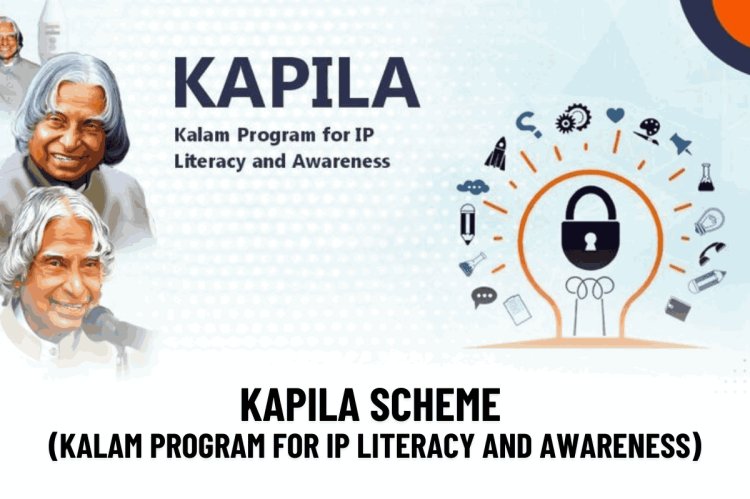KAPILA Scheme (Kalam Program for IP Literacy and Awareness)
The KAPILA (Kalam Program for Intellectual Property Literacy and Awareness) Scheme is an initiative launched by the Government of India implemented under the MoE’s Innovation Cell/AICTE to promote intellectual property (IP) awareness and patent filing across higher education institutions (HEIs). This program not only aims to educate students and faculty on the importance of IP but also provides financial support for patent filing. Through this scheme, the government is fostering a culture of innovation and intellectual property protection, aligning India with global standards. In this blog post, we will explore the objectives, process, benefits, and outcomes of the KAPILA Scheme, along with its role in shaping India’s IP ecosystem.

Introduction: Understanding the KAPILA Scheme
In today’s fast-paced, innovation-driven world, intellectual property (IP) is becoming an essential asset for individuals and institutions alike. Recognizing the need for a robust IP ecosystem in India, the government launched the “KAPILA Scheme”, or the “Kalam Program for Intellectual Property Literacy and Awareness”. This initiative aims to spread awareness about intellectual property rights (IPR), patent filing processes, and the importance of protecting innovations among students and faculty in higher education institutions (HEIs).
The KAPILA Scheme is part of a larger effort to create an IP-conscious academic environment where innovations are systematically protected and nurtured for commercial use. With the scheme offering financial assistance for patent filing, the government hopes to encourage more research, innovation, and entrepreneurship in educational institutions across the country.
Objectives of the KAPILA Scheme
The KAPILA Scheme serves multiple goals, all focused on building a strong foundation for IP awareness and protection in India. Here are the key objectives:
1. Promoting Intellectual Property Awareness: The primary aim is to create widespread awareness about intellectual property rights (IPRs) and their importance, especially in higher education institutions. By educating students and faculty, the program ensures they understand the mechanisms involved in filing for IP in both India and global markets.
2. Encouraging Patent Filing: The scheme seeks to boost the filing of patents by providing financial support and assistance to institutions. Patents are critical in safeguarding new ideas and innovations, and this initiative simplifies the process for educational institutions.
3. Fostering a Culture of Innovation: Through this program, the government wants to build a culture where innovation is systematically protected and commercialized, contributing to India’s position in the global innovation ecosystem.
4. Facilitating the IP Filing Ecosystem in HEIs: By creating an efficient IP filing system within academic institutions, KAPILA aims to make patenting a regular part of research activities in HEIs.
The Application Process
The application process under the KAPILA Scheme is designed to be straightforward, ensuring that eligible institutions can easily access the benefits. Here’s how it works:
1. Online Submission: Institutions interested in receiving financial assistance must submit their patent application details via the “KAPILA portal”. This includes the title of the patent, the date of filing, and details of the applicant/co-applicant, along with a copy of the patent application fee receipt.
2. Screening and Scrutiny: Once the application is submitted, it undergoes screening at the institute level to verify the correctness of the data. After this internal check, the application is forwarded to the Ministry of Education’s Innovation Cell (MIC) for further review.
3. Final Decision: Based on the recommendations of an expert committee, MIC makes the final decision on grant approval, considering the availability of funds. Approved institutions receive funding in reimbursement mode, allowing them to cover patent filing costs retrospectively.
Funding Assistance and Support
One of the standout features of the KAPILA Scheme is the financial support it offers to higher education institutions for filing patent applications. Here’s how the funding works:
1. Funding Amount: The scheme provides financial assistance of up to ₹2800 per patent application. Each institution can submit up to 40 applications per year, which means a total of ₹1,12,000 can be availed annually for patent filings.
2. Reimbursement Mode: The scheme operates on a reimbursement basis, meaning the scheme will fund up to 40 applications per institutions covering 50% of the total application costs where the institutes will initially pay for patent application fees and later be reimbursed by MIC. This includes both the filing fee and the examination fee for the patent.
3. Maximum Applications: Institutions are allowed to submit a maximum of 40 patent applications per year under this scheme. This ensures that the benefits are distributed equitably and that more institutions get the opportunity to access funding.
Formation of Committees and Application Review Process
To ensure the efficient implementation of the KAPILA Scheme, each participating institution must form a dedicated committee. This committee oversees the entire process, from identifying promising inventions to filing patents. The formation and roles of this committee are crucial to the success of the patent application:
1. Committee Composition: The committee should consist of five members- two faculty members with (experience in IP and translated to commercialisation), two industry experts (having experience in technology commercialisation), and one legal advisor specializing in intellectual property rights.
2. Evaluation Process: All patent applications are reviewed by this committee before submission. The institution’s IPR cell or incubation center acts as a facilitator in this process, coordinating services but not influencing the decision-making process.
Benefits of the KAPILA Scheme
The KAPILA Scheme brings numerous benefits to students, faculty, and educational institutions. Here are some of the key advantages:
1. Encouraging Innovation in Academia: By providing financial support for patent filings, the KAPILA Scheme motivates students and faculty to pursue research and innovation. This, in turn, leads to the development of new products, technologies, and solutions that can have both national and global relevance.
2. Reducing the Financial Burden: Patent filing can be a costly affair, especially for educational institutions with limited resources. The scheme reduces this financial burden, making it easier for institutions to protect their innovations.
3. Building IP Literacy: The program serves as a crucial learning tool, spreading awareness about the importance of intellectual property and encouraging more academic institutions to build strong IP ecosystems.
4. National Innovation and Entrepreneurship Initiatives: KAPILA integrates with other national initiatives like Innovation and Entrepreneurship Cells (IIC) and National Innovation Contests, further embedding the culture of innovation and IP awareness into academic environments.
What to expect?
The KAPILA Scheme is designed to have long-lasting effects on India’s intellectual property ecosystem, especially in the context of higher education institutions. Some of the expected outcomes may include:
1. Increased Patent Filings: With the financial support and awareness generated through this program, the goal is to file at least 10,000 patent applications annually. This surge in filings will reflect India’s growing role in the global innovation ecosystem.
2. Enhanced IP Culture in HEIs: The scheme aims to establish a more vibrant culture of intellectual property literacy within academic institutions. This not only encourages more innovation but also helps institutions participate actively in various entrepreneurship and innovation contests.
3. Strengthening Connections: The KAPILA Scheme seeks to connect HEIs, especially those located in the Himalayan region, North Eastern areas, and Aspirational Districts, with the national innovation ecosystem, ensuring that these regions benefit from the same opportunities as their more central counterparts.
4. Active participation and involvement of students, faculties and staff.
5. Sensitization and vibrant IP filing ecosystem in HEIs.
Conclusion
The “KAPILA Scheme” is a well-thought-out initiative that recognizes the importance of intellectual property and innovation in today’s academic landscape. By offering financial support and spreading IP awareness, the program is helping to cultivate a generation of students and faculty who understand the value of protecting their ideas. This initiative not only benefits individual institutions but also plays a key role in shaping India’s position in the global patent landscape.
As more educational institutions embrace the KAPILA Scheme, we can expect a more dynamic and competitive environment where innovations thrive, and intellectual property is both valued and protected. Ultimately, the scheme is laying the foundation for a stronger, more resilient ecosystem for research, innovation, and IP filing in India.












